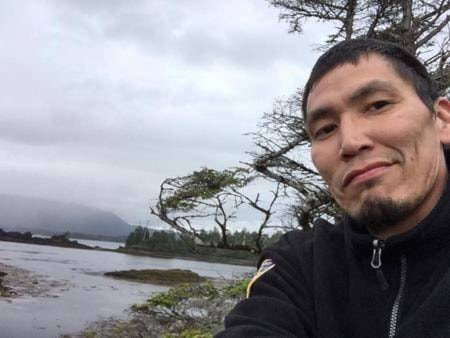The evidence of Travis Damon Thomas’s survival is scarce but his uncle says it’s scattered around a remote island off the coast of Vancouver Island: a circle of footprints, the remains of a sea urchin, a burned log.
Occasionally, the 41-year-old who is listed as a missing person by the RCMP has been spotted.
Thomas was sent to Bartlett Island near Tofino in July as part of an Indigenous tradition to help him heal from addiction and other ailments, said Alfred Dick, his uncle.
But the traditional method of the Ahousaht First Nation didn’t go as planned, Dick said, when Thomas didn’t return home after two weeks.
READ MORE: Police ask for public’s help in locating Ahousaht First Nation man
“Something just went awry on this one,” Dick said.
Seven months later, friends and family visit the island daily to leave food and other supplies for Thomas and try to coax him home.
“When we start a healing journey within our nation — if you’re having troubles, maybe addiction or something of that sort — we usually bring them to an island or isolated area where they can be by themselves and find themselves for roughly about two weeks before we let anyone join them and start helping and counselling them,” Dick said from the island as he dropped off supplies.
“He got put on the island and when they come to check on him he wasn’t around. All the signs were here that he was here, but he was nowhere to be seen, he went into the bush.”
Family and friends now believe Thomas was dealing with deeper mental illness than they were aware of. He had also faced several devastating challenges in recent years including the death of his wife, Dick said.
The island, which is only about 1.5 kilometres long and 700 metres wide, has regularly been used as a site for traditional healing but members of the First Nation usually stick to the beaches instead of the dense inland forest.
The RCMP say Thomas was last seen on the island on Aug. 7. When he couldn’t be found, his family conducted its own search.
Dick said five days was the longest stretch of time that passed without any evidence of Thomas.
RCMP ground and air patrols, local search and rescue teams, and the Canadian Coast Guard have conducted an extensive but unsuccessful search. On Oct. 18, more than 200 ground search volunteers and 20 vessels combed the island and surrounding waters, the RCMP say.
“Our search is unfortunately very difficult given the island’s extremely dense forest and brush area,” Sgt. Todd Pebernat says in the statement issued in November, which the Mounties say still stands when they were asked for an interview earlier this month.
The missing person file remains open and while the formal search has been suspended, local efforts continue.
The Mounties say they have no information to suggest Thomas had left the island but “are alive to the possibility that he may no longer be there.”
“The desire to find Mr. Thomas remains within all of us. To this end, the RCMP has maintained its presence of trail cameras on the island and examines any new reports of possible sightings or compelling leads,” the statement says.
Elder Dave Frank, who is a cultural support worker with Ahousaht’s wellness department, said he believes Thomas just needs more time.
“Without seeing him or talking to him, I don’t know what his mental state is right now. On a physical state, he’s doing OK,” Frank said.
When an individual is sent to the island, it’s a decision made by the family, he said. But the department provides support, including sending a counsellor to the island for one-on-one time with the individual, he said.
“Where I come from, we live in the best of two worlds. We live in a Western society with Western expertise and medical and all those things, and we also live in a world of the old ways too,” he said.
Providing an individual with supplies is also newer practice, he said, because in the past a person would only be left with tools and medicine.
The department leaves it up to the family to decide when a loved one is ready to return home. There have been cases when a family has pulled the individual back early because he or she appears to be suffering instead of healing, he said, and there are cases where someone hasn’t returned home for one or two years.
There have been more successful cases than failed ones, he said.
“When you get out there, it changes you, you’re forced to look within yourself,” he said. “They begin to take a look at themselves and move forward.”
About half a dozen family and friends visit the island every day and Thomas’s Facebook page express love and affection for him.
“We’re just praying and hoping that he comes to us soon,” Dick said.
Amy Smart, The Canadian Press
Like us on Facebook and follow us on
